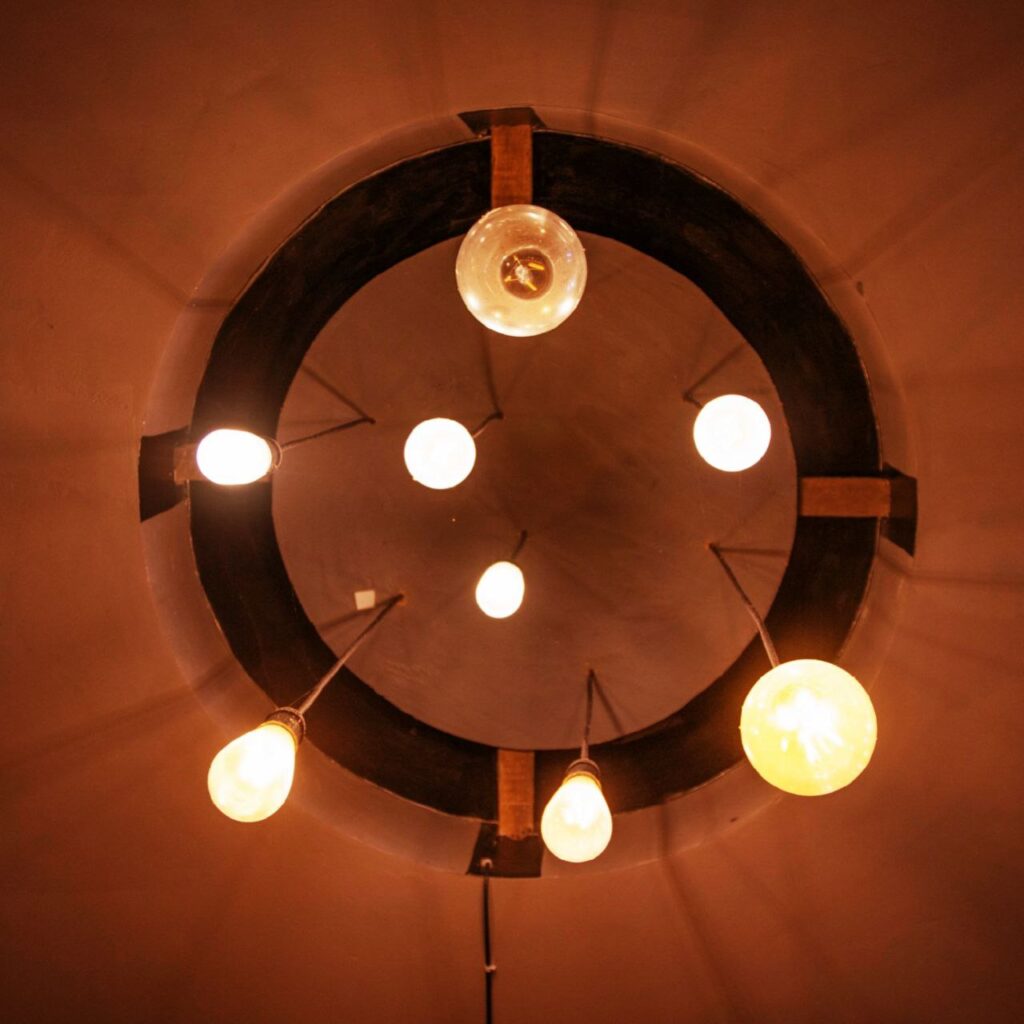Introduction of which ceiling light gives the most light
With so many options available, how do you ascertain which ceiling light gives the most light?When it comes to illuminating your living space, ceiling lights play a pivotal role in providing ample brightness. When selecting ceiling lights that will make your room brighter, consider factors such as functionality, design aesthetics, and personal preference. By choosing the right kind of ceiling lights tailored to your needs, you’ll ensure that every corner of your space shines brightly with captivating radiance!

What kind of ceiling lights make room brighter
When it comes to making a room brighter, the type of ceiling lights you choose can make all the difference.
One option that is known for its ability to provide ample illumination is recessed lighting. These fixtures are installed into the ceiling and emit a wide beam of light, evenly distributing brightness throughout the space.
Another popular choice for brightening up a room is track lighting. With adjustable heads that can be directed towards specific areas, track lights allow you to focus the light exactly where you need it most. This versatility makes them ideal for highlighting artwork or creating task-oriented lighting in kitchens or home offices.
For a more contemporary and stylish look, pendant lights are an excellent choice. These hanging fixtures come in various sizes and designs and can add both decorative flair and functional brightness to any room. Whether used individually or in clusters, pendant lights create a stunning visual impact while providing ample illumination.
If you prefer a more traditional style with maximum brightness, chandeliers are your go-to option. These ornamental light fixtures not only add elegance but also radiate abundant light through multiple bulbs arranged on delicate arms or branches.
Why are LED ceiling lights so bright
LED ceiling lights are known for their exceptional brightness, making them a popular choice for many homeowners and businesses alike. But what exactly makes LED lights so bright?
LED stands for “light-emitting diode,” which is a semiconductor device that emits light when an electrical current passes through it. Unlike traditional incandescent bulbs, which rely on heating a filament to produce light, LEDs convert electricity directly into light using a process called electroluminescence.
One key factor contributing to the brightness of LED ceiling lights is their efficiency. LEDs are incredibly energy-efficient compared to other lighting options, such as fluorescent or halogen bulbs. They require less power to emit the same amount of light, resulting in brighter illumination while consuming less electricity.
Additionally, LED lights have superior directional properties compared to traditional bulbs. They emit light in specific directions rather than dispersing it in all directions like incandescent or fluorescent bulbs do. This focused directionality allows LED ceiling lights to deliver concentrated and intense illumination precisely where it’s needed most.
Furthermore, LEDs can produce different color temperatures ranging from cool white to warm white. Cool white LEDs have higher color temperatures (around 5000-6000K) and emit a crisp and vibrant light that mimics natural daylight. On the other hand, warm white LEDs have lower color temperatures (around 2700-3000K) and provide a softer and more soothing glow similar to traditional incandescent lighting.
In conclusion , by harnessing advanced technology like electroluminescence and efficient energy conversion processes, LED ceiling lights offer unparalleled brightness compared to other types of lighting fixtures available on the market today. Whether you’re looking for maximum visibility or creating an inviting ambiance in your space, opting for LED ceiling lights will undoubtedly bring optimal brightness levels while saving energy at the same time.
What is brighter cool white and warm white
When it comes to choosing the right ceiling light for your space, one important factor to consider is the color temperature of the light. Cool white and warm white are two common options, but what exactly do these terms mean and which one is brighter?
Cool white light has a higher color temperature, typically ranging from 5000K to 6500K. It emits a crisp and bright light that closely resembles daylight. This type of lighting is often preferred in areas where tasks require good visibility, such as kitchens or workspaces.
On the other hand, warm white light has a lower color temperature, usually between 2700K and 3500K. It gives off a soft and cozy glow that creates a more relaxed atmosphere. Warm white lighting is commonly used in living rooms, bedrooms, or dining areas where comfort and relaxation are desired.
In terms of brightness, both cool white and warm white lights can be equally bright when compared at similar wattages. However, due to its higher color temperature, cool white light may appear slightly brighter to some individuals.
The choice between cool white and warm white comes down to personal preference and the intended ambiance you want to create in your space. Consider factors such as room size, purpose of lighting (task-oriented or mood-setting), as well as any existing decor elements when making your decision.
Remember that experimenting with different types of lighting can help you find the perfect balance between brightness and ambiance for your specific needs!
How do I choose a bright ceiling light
When it comes to choosing a bright ceiling light, there are several factors you need to consider.
One of the most important factors is the wattage or lumen output of the light fixture. The higher the wattage or lumen output, the brighter the light will be.
Another factor to consider is the type of bulb used in the ceiling light. LED bulbs are known for their brightness and energy efficiency. They produce a crisp and clear light that can instantly brighten up any room.
In addition to wattage and bulb type, you should also think about color temperature when choosing a bright ceiling light. Cool white lights have a bluish hue and create a bright, vibrant atmosphere. Warm white lights have a yellowish hue and create a cozy, inviting ambiance.
The size and design of the ceiling light fixture can also affect its brightness. Larger fixtures with multiple bulbs or adjustable panels can provide more overall illumination in a space.
It’s essential to consider your personal preferences and needs when selecting a bright ceiling light. Think about where you’ll be using it – whether it’s for task lighting in an office or ambient lighting in a living room – as well as any specific style requirements you may have.
By taking these considerations into account, you can choose a bright ceiling light that not only illuminates your space but also enhances its overall aesthetic appeal!
How to maintain ceiling lights
Maintaining your ceiling lights is important to ensure they continue to provide optimal brightness and functionality. Here are some tips to help you keep your ceiling lights in top condition.
Regular cleaning is essential for maintaining the brightness of your ceiling lights. Dust and dirt can accumulate on the surface of the light fixtures, obstructing the light output. Use a soft cloth or duster to gently wipe away any debris from the surface of the lights.
In addition to cleaning, it’s also crucial to check for any loose connections or wiring issues that may affect the performance of your ceiling lights. Inspect the wires carefully and make sure they are securely connected. If you notice any damage or frayed wires, it’s best to consult a professional electrician for repairs.
Another important maintenance tip is to replace burnt-out bulbs promptly. A single dim bulb can significantly reduce overall lighting effectiveness in a room. Keep spare bulbs on hand so that you can quickly replace them when needed.
Furthermore, consider using LED bulbs in your ceiling lights as they tend to have longer lifespans compared to traditional incandescent bulbs. LEDs not only provide bright illumination but also consume less energy, making them an eco-friendly choice.
Don’t forget about proper ventilation around your ceiling lights. Overheating can lead to reduced lifespan and potential fire hazards. Ensure that there is adequate airflow around the light fixtures by avoiding blocking vents or placing objects too close.
By following these maintenance practices regularly, you can ensure that your ceiling lights remain bright and functional for years to come!
Frequently asked questions
Q1.Are LED lights bright enough ?
Ans.LED lights are incredibly bright and can provide sufficient illumination for various purposes. With advancements in technology, LED lights have become even brighter, making them a popular choice for both residential and commercial lighting solutions.
Q2.How many lumens is good enough for ceiling lights ?
Ans.The number of lumens needed for ceiling lights depends on the size of the room and the desired level of brightness. As a general guideline, a range of 800 to 1500 lumens is considered suitable for most average-sized rooms.
Q3.How many lumens do I need for high ceiling?
Ans.For high ceilings, it is recommended to have higher lumen output to compensate for the increased height. A range of 1500 to 3000 lumens or more may be required, depending on the specific height and size of the room.
Q4.Why is my ceiling light dim ?
Ans.There could be several reasons for a dim ceiling light, including a low wattage bulb, a faulty or outdated fixture, or a poor electrical connection. Checking these factors and making necessary adjustments or replacements can help improve the brightness of your ceiling light
Q5.How can I increase the light in my room without a false ceiling ?
Ans.There are several ways to increase the light in a room without a false ceiling. You can maximize natural light by using sheer curtains or removing obstacles near windows, opt for lighter-colored walls and furniture to reflect more light, strategically place mirrors to bounce light around the room, and choose higher lumen output bulbs or add additional lighting fixtures for brighter illumination.
Q6.What ceiling light mimics sunlight?
Ans.Full-spectrum LED lights are known to mimic sunlight by providing a wide range of colors and intensities similar to natural daylight. These lights can create a bright, natural-looking illumination that can help improve mood and provide a more vibrant and realistic lighting experience in indoor spaces.
Q7.What ceiling light is good in a bedroom?
Ans.When choosing a ceiling light for a bedroom, it is often best to opt for fixtures that offer adjustable brightness levels, such as dimmable LED lights, to provide the flexibility to create both bright and cozy lighting atmospheres. Additionally, fixtures with warm white or soft white color temperatures are typically preferred in bedrooms for a calming and relaxing ambiance.
Conclusion
When searching for a ceiling light that provides ample illumination, LED lights are often the best choice due to their high brightness levels and energy efficiency. Understanding the difference between cool white and warm white lighting can help you select which one will suit your needs better.
Remember to take into consideration factors such as room size, type of fixture, and regular maintenance when choosing a bright ceiling light for your space. With these considerations in mind, you’ll be able to find an illuminating solution that brings both functionality and style into any room!
Enjoying the post ! Read more…



